W&M报告(五):音乐NFT项目发行的粉丝情绪分析
原文作者:Water & Music
原文翻译:Vera
本文来自The SeeDAO。
相关阅读:
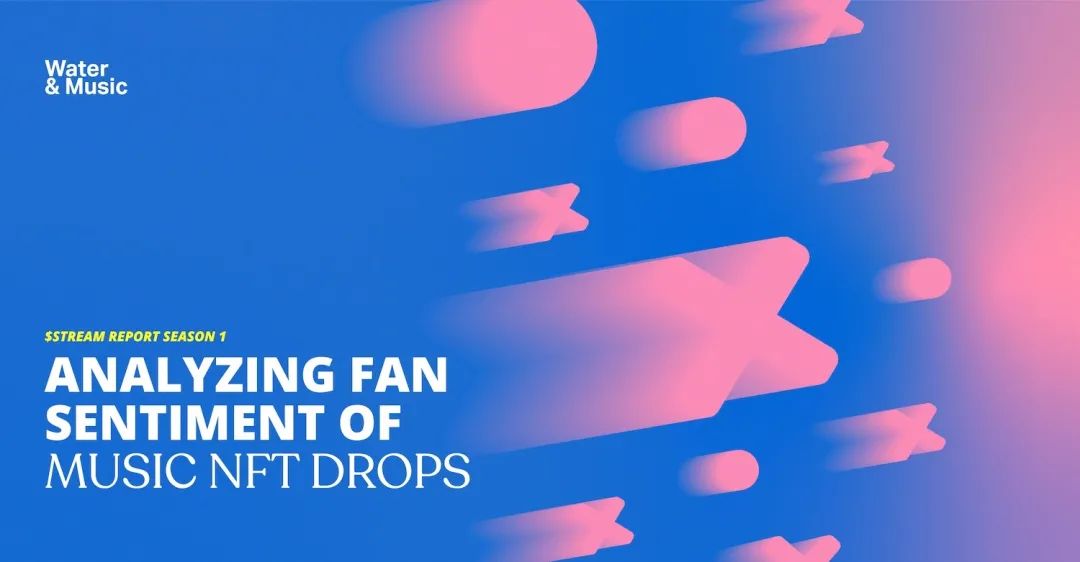
太长不看版:
2020 年 10 月至 2021 年 11 月期间,推特上有数百个音乐 NFT 项目正式发行,为了全面客观地观察音乐 NFT 产业的粉丝情绪状况,我们依据推特数据绘制了一份时间图谱,以此追踪粉丝们对 NFT 发行的反应。我们针对几项常见的社交媒体传播策略开展了压力测试,分析各项策略在音乐 NFT 推广方面的有效性,结果显示艺术家们很难通过推特平台消除粉丝对 NFT 的疑虑,或扭转大势所趋下的粉丝情绪。此外,我们也发现推特数据有时并不能准确反映粉丝对不同音乐 NFT 的情绪感受,因此,仅凭推特数据推断一个 NFT 项目的长期吸粉潜力是不可靠的。
在过去两个月中,Water & Music 社区就音乐和 Web3 现状合作撰写了研究报告「五部曲」,本篇为系列终篇。本文为关于音乐 NFT 项目发行的粉丝情绪分析报告,报告贡献者名单请见文章底部(按首字母排序)。你也可以访问 stream.waterandmusic.com,阅读现已发布的全部报告内容,以及完整的成员和贡献者名单。
Water & Music 社区在过去两个月完成了《音乐和 Web3 领域现状》系列研究报告,报告一共包含五个部分,这是第五部分。本文为关于音乐 NFT 项目发行的粉丝情绪分析报告,你可以访问 stream.waterandmusic.com 以查看该系列报告的更新,以及完整的贡献者列表。
仅去年一年,艺术家们就通过音乐 NFT 筹到了惊人的资金,部分业内人士也十分看好音乐 NFT 的潜力,认为是创意货币化的未来趋势。不过尽管如此,NFT 依旧饱受争议。除了业内人士,乐迷群体对音乐 NFT 也褒贬不一,他们在意的问题主要包括:NFT 不利于环境的可持续发展;NFT 是有钱人才有资格玩的游戏;以及在他们印象中 NFT 是割韭菜的金融骗局。
艺术家的成功离不开粉丝的支持,是粉丝们强大的消费力推动着艺术家的成长。鉴于此,我们有必要了解粉丝对音乐 NFT 这种新兴媒介的态度和反应。原因很简单:粉丝情绪会很大程度上影响艺术家的选择。不论是心理上(如自我认知)还是经济上(如生计收入),许多名人在事业上与粉丝的反馈有着诸多的内在联系。因此也不难理解,对 NFT 项目的负面评价影响的不单单是某一个艺术家,还关系到其他消费者和艺术家对 NFT 这一新趋势的看法。
2021 年,我们就见证了多位艺术家因粉丝的负面反馈而直接更改了 NFT 策略。比如,深受粉丝喜爱的 Jacob Collier 和 A.C.E. 均已撤回了所有的 NFT 发行,很大一部分原因是因为他们的粉丝担心区块链技术会对环境造成负面影响。DistroKid Sellouts 也经历了类似的情况,而像 Charli XCX、Interpol、Crazy Frog、Method Man 和 A$AP Rocky 一众人都业绩惨淡。于是,许多艺术家开始在营销文案中避开「NFT」一词,转而使用「藏品」或「数字艺术」等词替代。
鉴于当前这种现象,我们希望可以全面客观地洞察音乐 NFT 产业的粉丝情绪状况。为此,根据 2020 年 10 月至 2021 年 11 月期间推特上正式发行的数百个音乐 NFT 项目,我们绘制了一份时间图谱,以此追踪粉丝们对 NFT 发行的反应。本篇报告旨在对 NFT 产业中的粉丝情绪进行多方位全面考察,分析粉丝情绪随时间的变化趋势,并探究激发粉丝积极/消极反应的潜在原因和规律。本文与本系列第四篇报告「引导策略」互为补充,前者使用了大规模的定量数据分析,而后者多采用深度调研和案例研究,更注重定性数据分析。
01
研究方法
我们选择以推特作为主要数据源,绘制粉丝情绪图谱。推特除了是一个有数千万艺术家和粉丝入驻的大型社交平台外,还是一个聚集了大批 Web3 原生思想领袖和爱好者的交流平台。因此,如果要选择一个单一数据源来建立大型数据集的话,推特似乎是不二之选,它可以帮助我们准确捕捉音乐 NFT 产业中的粉丝情绪走向。
Water & Music 社区最初搭建了一个种子数据集,其中包含 200 多条音乐 NFT 发行的官宣推文。数据集采样主要集中在电子音乐领域(约占名单的 75%),也涵盖一些其它的音乐类型,比如嘻哈、K-pop 和摇滚。同时,我们也采集了每条 NFT 发行推文下的所有回复和引用,最终形成了一个包含约 6000 条推文的大型数据集。
我们将这些推文统统汇总起来,并为每个 NFT 项目发行生成了两项描述参数。
积极情绪的百分比值:范围从 0 到 100,代表积极情绪从零分到满分。我们通过 专门的推特文本情绪分析库,为数据集中的每条推文增加了积极/消极情感标签,并为每条 NFT 发行推文计算一个情绪值,代表原推文的所有引用或回复中积极情绪的百分比。
互动计数:NFT 发行的原推文和所有后续回复和引用中所收到的点赞和转发的总数。
通过收集每个 NFT 投放项目的相应数据点,我们初步绘制出了一份以时间为横轴的散点图(如下图所示):
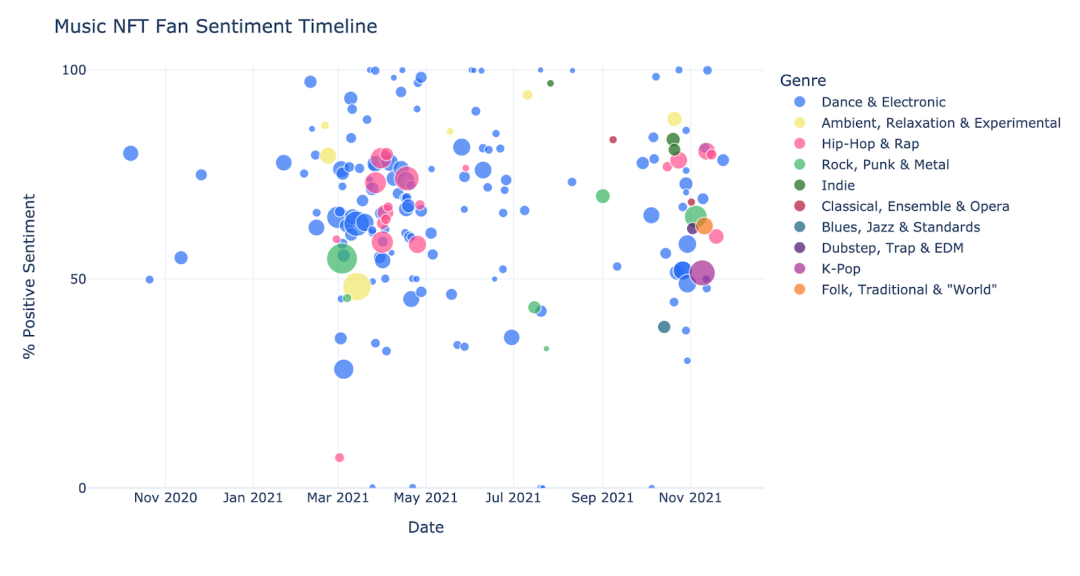
图中每一个点都对应着一个已公开发布的音乐 NFT 项目。横轴为项目官宣日期,纵轴为传递积极情绪的推特互动在所有互动中的占比。圆点的大小代表推特上的整体参与度,不同颜色对应着不同的艺术流派,流派分类取自音乐分析工具 Chartmetric。
同时,我们通过 Meltwater(社交媒体监测平台)抓取用户画像和在线行为数据,作为本次研究的补充材料。依据互动价值和产品/市场契合度两项指标,我们仔细筛选出了 8 个知名 NFT 发行项目,并针对他们使用的运营工具开展了调研。我们希望从中找到一些可能与粉丝情绪有关的蛛丝马迹,用以解释 NFT 项目的公告方式与粉丝的积极(或消极)情绪之间的内在联系。
02
研究发现
在 NFT 发行时间图谱中,我们观察到的首个明显特征是 NFT 发行量呈现出「两头密,中段稀」的不均匀分布状态:项目发行时间集中于 2021 年 2 月和 3 月,此后约 6 个月期间,发行量骤减,直至 10 月才开始回升。这与 2021 年 NFT 的总体走势吻合:2021 年初被认为是「NFT 旺季」,而随之到来的夏天则被称为「加密凛冬」。此外,这也与我们之前发布的 NFT 市场报告相符,数据显示 2021 年 Q2 的音乐 NFT 月销量相比 Q1 下降了 90%。
粉丝情绪指数则在纵向上广泛分布,其中多数集中在中段(50% 左右)和稍偏正向之间。这与 2021 年初的牛市行情和近来数月的回升趋势大致吻合,但与我们最初的设想略有不符。我们最初认为负面情绪的占比会更大,尤其是规模更大的艺术家项目。
在本数据集中,从具体流派来看,电子音乐是最具代表意义的项目类型,其粉丝情绪的走势与整体趋势最为接近,大多分布于中段(50% 左右)和稍偏正向之间。放眼整个音乐 NFT 市场,就销量而言,电子音乐 NFT 项目的数据也是最具代表性和指示意义的。
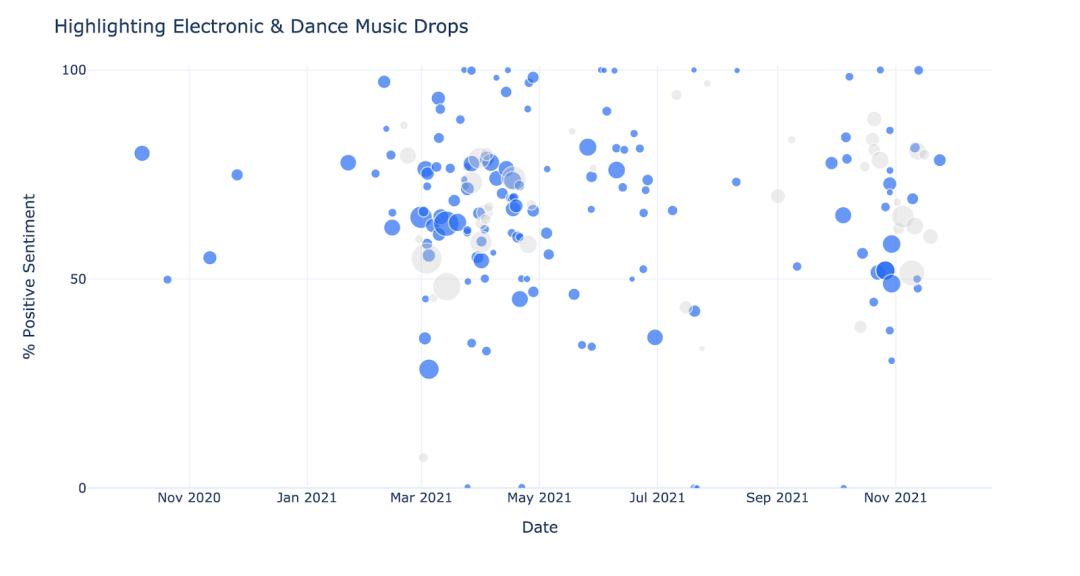
相比之下,嘻哈音乐的粉丝情绪走势略优于电子音乐,更偏正向。不过,在过去数月内,仅有零星几个 NFT 项目归属于该流派。
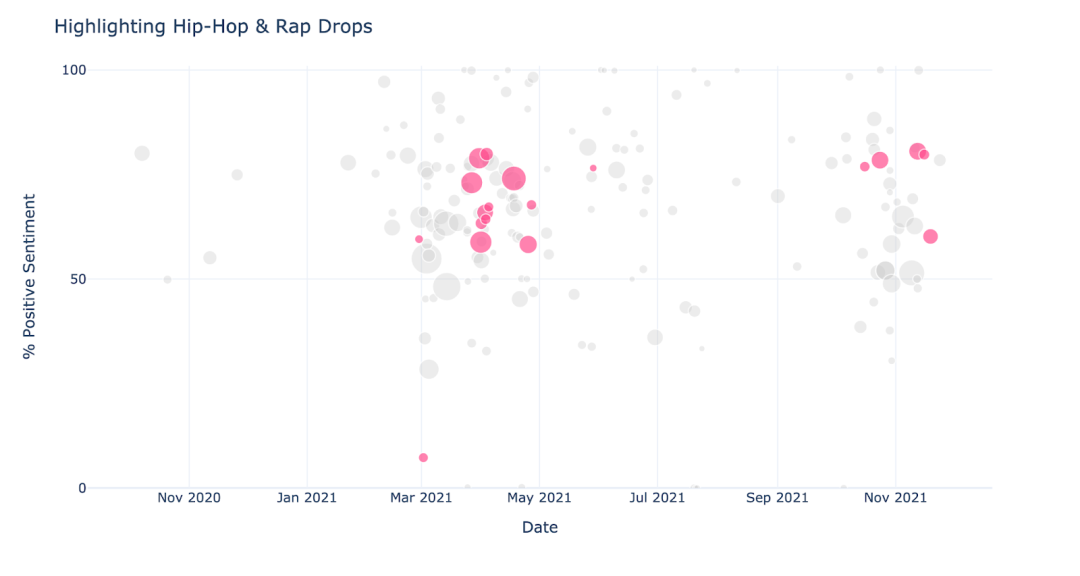
03
项目整体参与度与粉丝情绪的关联分析
我们起初认为,某些艺术家的粉丝群体明确,且体量不大,整体互动次数较低,由他们发行的 NFT 项目,可能更容易收到来自粉丝的正向反馈。我们的假设是,如果一个艺术家的受众广泛,彼此互动不紧密,且其中大部分人对 NFT 的认知尚浅,那么他发行的 NFT 项目可能会接收到更多的负面情绪。反之,我们认为受众「小而精」的艺术家具有潜在优势,更容易带领粉丝迈入 Web3,并围绕 NFT 项目构建一种更有凝聚力的叙事——每持有一份 NFT,都是对艺术家的创意工作的一份贡献和认可。
然而,结果显示该假设不成立。依据 NFT 项目的参与度等级,我们将它们分成了三类(参与度活跃、中等和不活跃),每一类中的项目数量一致。我们依据三种不同的参与度等级,依次绘制了粉丝情绪分布曲线(如下图),横轴代表积极情绪值所占百分比,纵轴代表对应百分比值的分布概率。
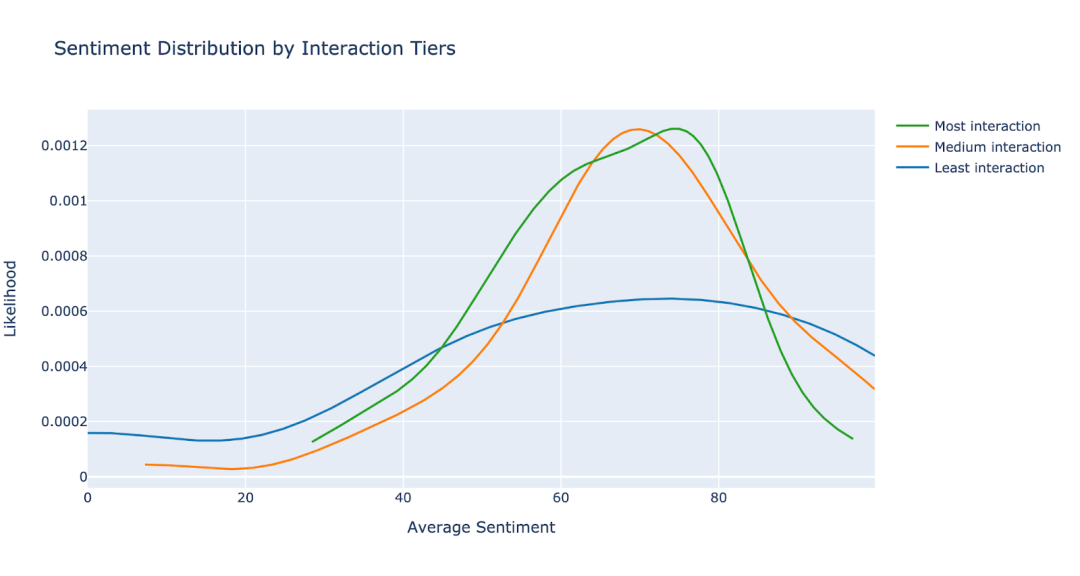
我们发现,三种参与度等级所对应的粉丝情绪分布趋势十分相近。换言之,NFT 项目的粉丝互动程度与粉丝情绪的正向程度之间的关联度不大。也就是说,现有数据无法有效论证「由小众艺术家发行的 NFT 会更受好评」这一假设。
不过,需要注意的是,该推导过程默认项目的整体互动程度与受众规模成正比,即假定了当艺术家的受众越广,原始 NFT 发行推文(及其评论和引用)所收到的点赞和转发总数越高。然而,实际情况可能并非如此,相较于受众「广而散」的艺术家,受众「小而精」的艺术家的粉丝参与度或许会更高。尽管分析结果显示,NFT 项目的 Twitter 粉丝整体参与度无法被用作衡量情绪的有效指标,但鉴于将整体互动程度等价于受众规模的划分方式存在偏差,我们无法准确评估受众规模和 NFT 项目成功率之间的关系。
04
解决粉丝疑虑无法有效引导积极情绪
本系列报告的「粉丝引导策略」篇中,为反映粉丝们对 Web3 领域的最大疑虑,我们统计并绘制了一个由四项常见疑虑组成的轴线图谱,依据艺术家仅凭引导策略即可消除或缓解粉丝疑虑的可能性,从左至右依次排列。
研究结果显示,对环境的影响和高昂的财务支出是粉丝们最担心的问题,尤其是那些对 Web3 认知尚浅的用户。有趣的是,该结果与我们采集到的 Twitter 数据吻合。以 50% 为分界线,我们将数据集划分为积极情绪(正向反馈占比 50% 及以上)和消极情绪两个类别,并提取了粉丝在 Twitter 互动中最常使用的 30 个关键词。其中,「环境」和「金钱」都是高频关键词。

不幸的是,轴线图谱显示,艺术家们仅凭一己之力解决这两项问题的可能性是极低的。本质上,它们背后涉及到的是区块链网络整体的局限性,让艺术家们「背锅」显然是不合理的。
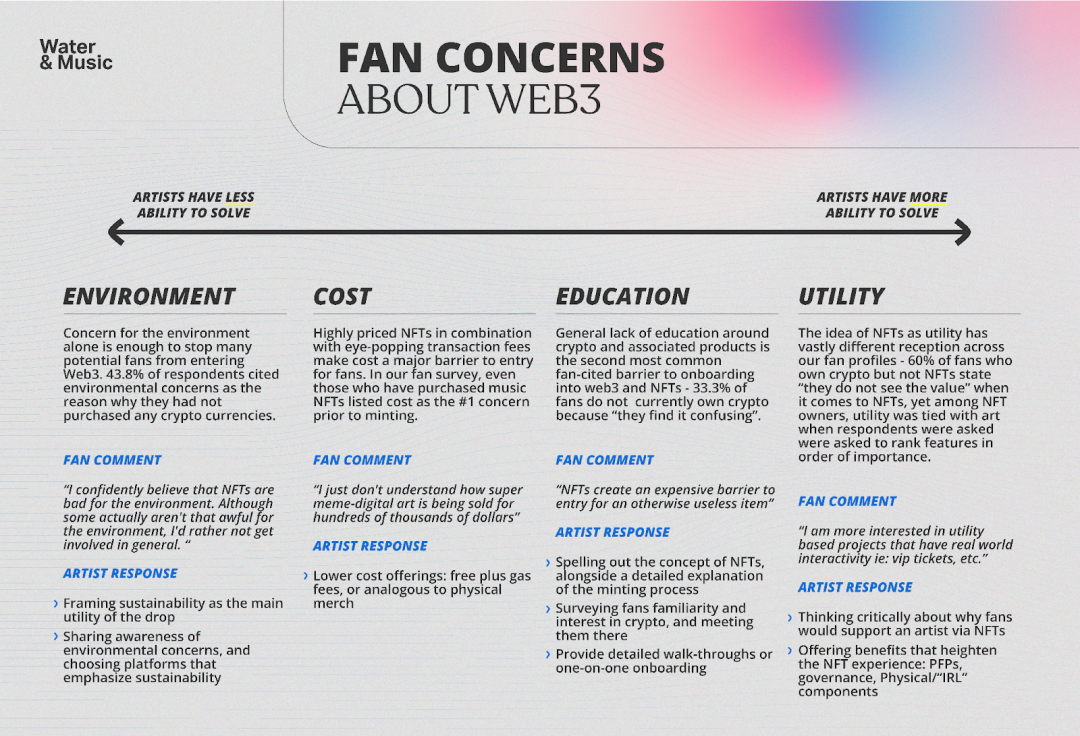
此外,情绪分析结果显示,即使艺术家们付诸行动,尝试在推文或新闻稿中针对环境影响和金钱成本两项问题提供解决方案,也无法对粉丝情绪产生积极影响。甚至可能加剧粉丝的抵触,责怪艺术家没有能力解决这些问题。
除了「粉丝常见疑虑」框架中的定性数据外,我们还扫描了数据集中的所有 NFT 发行项目(的官宣推文和初始项目页面),抓取其中提及到慈善和环保事业(或意图)的内容。
依据我们选取的数据集来看,NFT 项目是否提及其慈善事业(或意图)对粉丝情绪的总体走势影响甚微(如下图所示)。事实上,甚至有少数几个慈善性 NFT 发行项目被标记为「负面情绪占比更大」。例如,2021 年 3 月 Charli XCX 在 Foundation 上发行的 NFT 项目,该项目将部分收益捐赠给了 Girls Make Beats。这种粉丝情绪走势与整个音乐行业(及 W&M 社区内部)基本吻合。显然,仅在 NFT 项目发行初期加入慈善元素,并不足以打消粉丝对该产业形式的种种疑虑,也无法解决加密新手一贯面临的财务成本和技术障碍问题。
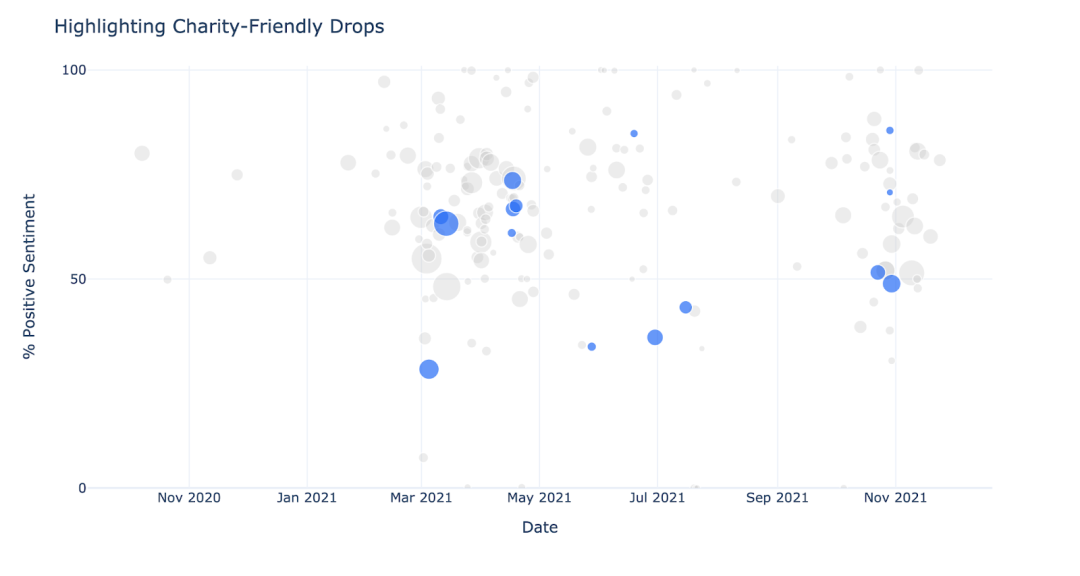
我们还在数据集中抓取了提及环保意识或碳中和倡议的 NFT 发行项目,结果显示,它们的积极情绪平均占比略高于行业整体情况(如下图所示),但由于数据集中包含的碳中和项目信息太少,无法确定该结论是否具有统计学意义。此外,与上述的慈善属性项目同理,如果在推广 NFT 发行项目时过于强调其可持续发展性,可能过犹不及,导致「可持续发展」成为项目的唯一关注点,忽视粉丝的实际体验感受。正如「粉丝引导策略」篇中所述,NFT 发行项目的推文和新闻稿中侧重呈现的环境相关信息,实际上掩盖了粉丝在进入 Web3 时可能面临的额外外部因素和入门障碍。例如,用户需要在主网上购买 ETH,并将其转移至 Polygon、Tezos 等低成本二级网络,才能购买「碳中性」NFT。
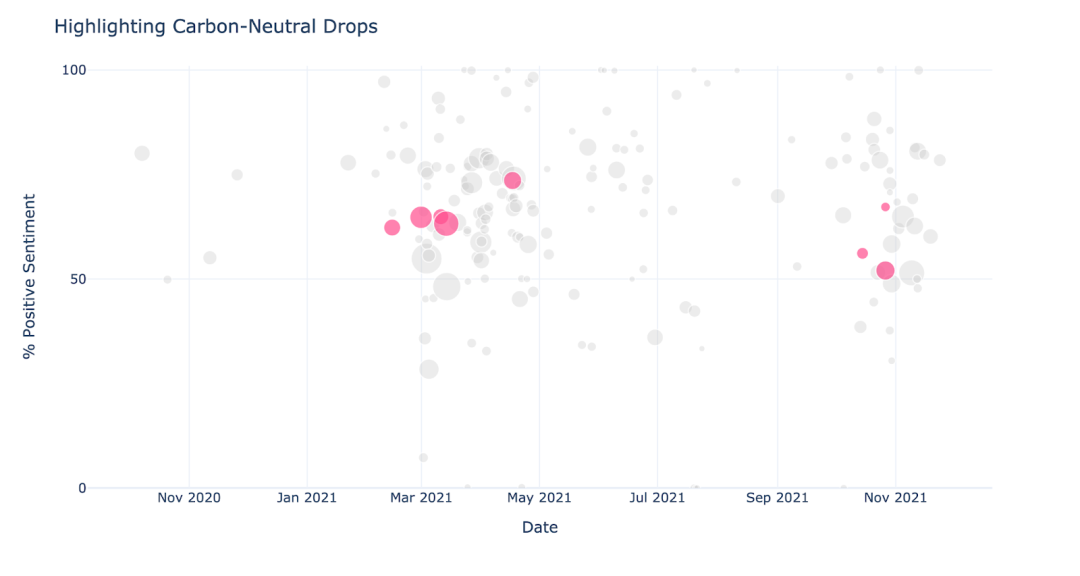
05
粉丝画像对整体情绪走势的重要性
如果想要全方位地了解 NFT 项目的粉丝情绪状况,就需要从粉丝的角度分析其中的「推拉因素」。换言之,上文的大部分图表均是以自上而下的视角,评估粉丝对艺术家传递出的信息的反应,尤其是那些与碳中和、慈善相关的倡议。然而,为了使数据更具说服力,我们还需要以自下而上的视角,分析粉丝们的动机和背景,这或许能帮助我们了解:对于粉丝而言,Web3 的哪些领域是 TA 们想要率先参与的。
为此,我们选取了一部分今年最受欢迎、收益最高的音乐 NFT 发行项目,并使用 Meltwater 调取了参与者的数据,包括基本个人信息、心理统计数据和兴趣爱好。经分析,我们观察到一个明显的现象:Twitter 上几个高知名度的音乐 NFT 发行项目的核心受众都是「Web3 原住民」。TA 们在自我介绍时经常使用「收藏家」、「加密货币」和「NFT」等词汇,并且都关注了多个知名的加密圈博主。换句话说,TA 们是狂热的加密货币爱好者,而不是音乐艺术家的「铁杆」粉丝。
以 3LAU 在 Nifty Gateway 上发行的 Faces 项目为例,我们先来分析一下它的整体受众数据(点击查看 Twitter 公告)。数据集显示,在粉丝情绪方面,由 3LAU 发行的多个项目的正向情绪占比都极高,平均比率约为 80%。不过,这并不奇怪。因为 3LAU 是一个「加密原生」的艺术家,这可以从多方面得到印证。比如,他从很早期(最晚 2018 年)就开始参与区块链活动,且曾在大学修读金融专业,因此,他可以从容地与关注者们讨论音乐、金融和加密货币这几个领域是如何产生交集的。

我们使用 Meltwater 对 Faces 项目的受众进行了可视化分析(如上图所示),其受众分布图中呈现出多个清晰的集群,这意味着 TA 们在加密领域的正向体验更多,至少参与度更高。这些集群的关键词包括**「交易 / 账户」、「NFT 收藏家 / degen」、「opensea / 创造性」和「投资者 / ape」**。此外,TA 们在 Twitter 上用来描述自己有关的关键词也多与加密艺术相关。其中,「NFT」占29.5%,「NFTs」占15.0%,「收藏家」占10.7%,「艺术」占10%,「加密」占9.3%。
其次,可视化图谱的「喜爱度」板块数据显示,在该项目的受众共同关注的博主中,最受欢迎的几个博主都与加密领域或 NFT 艺术市场有关(Elon Musk、Nifty Gateway、Beeple 和 Pak)。最后,数据显示该项目的受众中有 78.38% 是男性。以上这些因素几乎完全吻合我们对「加密迷弟」的刻板印象(通常指喜欢在社交媒体上使用加密术语作为个人标签的男性),这一类人或许更可能对 NFT 项目展现出正向情绪,并积极参与其中。当然,不排除这一结论有以偏概全的嫌疑。
我们分析的另外几个项目也显示相同的结果,即正向情绪占比高的项目的受众往往是加密重度用户:
Dirtybird Flight Club :受众中男性占比 77.79%;个人关键词构成:「NFT」占 21.6%,「加密」占 13%,「NFTs」占 9.8%,「收藏家」占 6.0%;推文互动中正向情绪占比 85%。
Ice Cube / Trevor Jones on Nifty Gateway :受众中男性占比 73.45%;个人关键词构成:「NFT」占 20.6%,「加密」占 11.5%,「NFTs」占 9.1%,「收藏家」占 6.0%;推文互动中正向情绪占比 80%。
Method Man / Tical :受众中男性占比 76.66%;个人关键词构成:「NFT」占 17.8%,「加密」占 9.3%,「nbatopshot」占 6.8%;推文互动中正向情绪占比 60%。
反观 2021 年 3 月由 Grimes 在 Nifty Gateway 上发行的 WarNymph 项目(Twitter 公告:链接 1,链接 2),其受众的回复、评论等互动内容并非围绕加密领域展开(如下图所示)。TA 们最常提及的关键词是 「爱」、「音乐」和「艺术」,而「加密」仅排第四,且仅有 2% 左右的受众在共同使用这些关键词,这与 3LAU 的 Faces 项目以及 Dirtybird Flight Club 形成鲜明对比。Dirtybird Flight Club 的受众中有超过 20% 的人在自我介绍中提到「加密」一词,呈现出明显的「Web3 原住民」属性。此外,与上文提及的其它 NFT 项目相比,WarNymph 的受众中男性占比略低(63%)。如可视化图谱右侧所示,其受众聚集的领域不仅限于加密和投资,用户画像十分多元化,主要标签包括「学生/技术」、「文化/政治」、「grimes/stan」。
综合上述因素,我们推测 WarNymph 项目的参与者主要是 Grimes 的长期忠实粉丝,而非所谓的「加密迷弟」们。有趣的是,据分析结果显示,该项目在 Twitter 上的粉丝情绪值并没有出现大幅下降,虽然正向情绪占比略低于上文提到的其它几个 NFT 项目(Grimes 的正向情绪占比为 62%,其它几个项目的正向情绪占比在 80% 上下),但项目整体的互动氛围仍以正向情绪为主导。
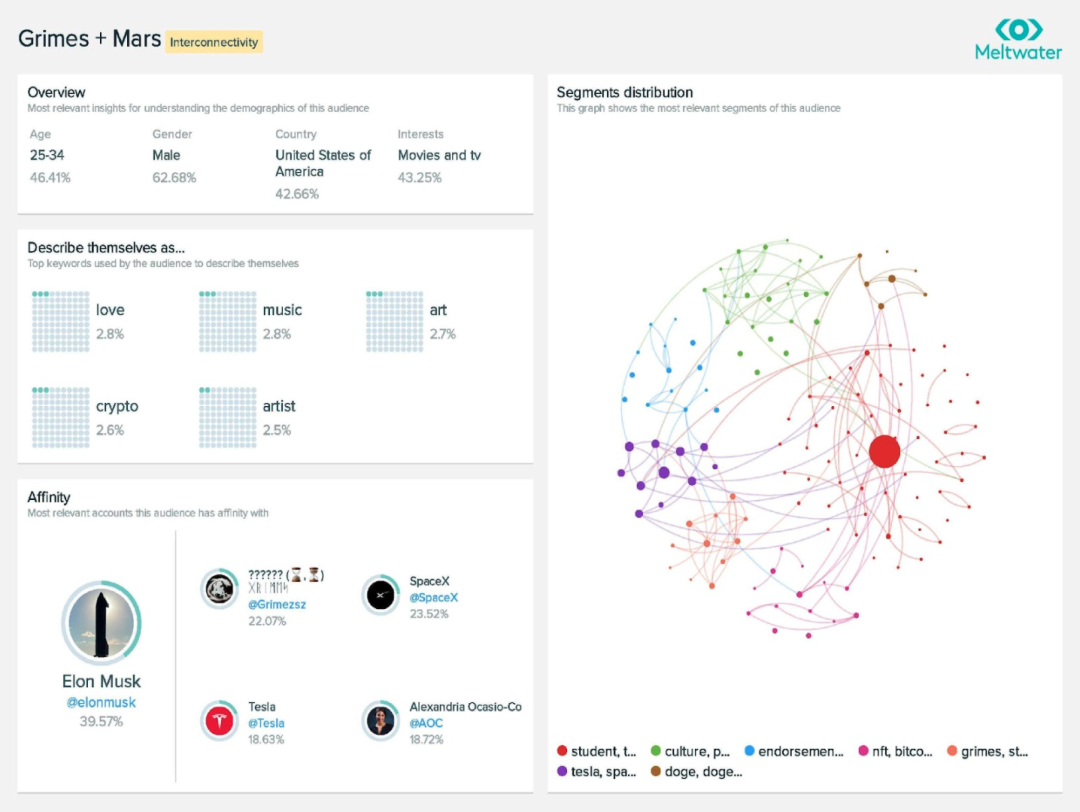
基于这些图表的信息,我们无法判断项目受众中加密原住民的比例能否作为衡量正向情绪占比的指标,两者间是否存在正相关性还有待进一步研究。也就是说,我们通过这项初步分析能够得出的唯一结论是:每个艺术家的粉丝群体都具备高度个性化的属性。同时,我们认为如果要建立一个全面客观的粉丝情绪模型,则有必要纳入一些相关的受众数据,比如,基本信息、兴趣爱好和核心关注点。
06
研究结论
基于这些图表的信息,我们无法判断项目受众中加密原住民的比例能否作为衡量正向情绪占比的指标,两者间是否存在正相关性还有待进一步研究。也就是说,我们通过这项初步分析能够得出的唯一结论是:每个艺术家的粉丝群体都具备高度个性化的属性。同时,我们认为如果要建立一个全面客观的粉丝情绪模型,则有必要纳入一些相关的受众数据,比如,基本信息、兴趣爱好和核心关注点。
事实证明,艺术家们很难通过 Twitter 平台消除粉丝对 NFT 的疑虑,以扭转粉丝情绪走势,尤其是有关环境问题和金钱成本的疑虑。整体而言,这可能是因为 Twitter 平台并不适合用于深度探讨这些复杂的话题(谁知道呢......)。
Twitter 数据无法完整地反映粉丝对音乐 NFT 的情绪感受。正如本文前言部分所述,艺术家们很可能因为担心在 Twitter 上收到负面评价,而不敢尝试 NFT 技术。然而,负面情绪并不一定意味着 NFT 项目的销售额低迷。以 Charli XCX 在 Foundation 上发行的 NFT 项目为例,虽然遭到了粉丝的集体反感,但其总售价接近 20 ETH。同样地,即便 Twitter 上的互动以正向情绪为主,也不一定代表 NFT 项目成功达成了吸引长期粉丝入驻、完成社区建设的目标。此外,对「成功」的定义也不一而同。一个新兴艺术家的「成功」标准和一个知名艺术家的「成功」标准可能相差甚远,特别是在社媒参与度方面。
最终,影响粉丝情绪的主要因素还是落回到以下两点:第一,艺术家与粉丝群体之间的关系是否足够牢固,这是音乐行业 Web3 项目的核心要点;第二,在主流叙事背景下,粉丝们对 NFT 作品的接受度。另外,我们可能需要留意那些不受我们掌控的外部因素(比如,区块链技术的环境成本),但我们需要优先考量的,依旧是可控范围内的杠杆(比如,真实的创造力、社区建设、良好的意图和价值观),并将这些作为发行 NFT 项目时的主要聚焦点。



